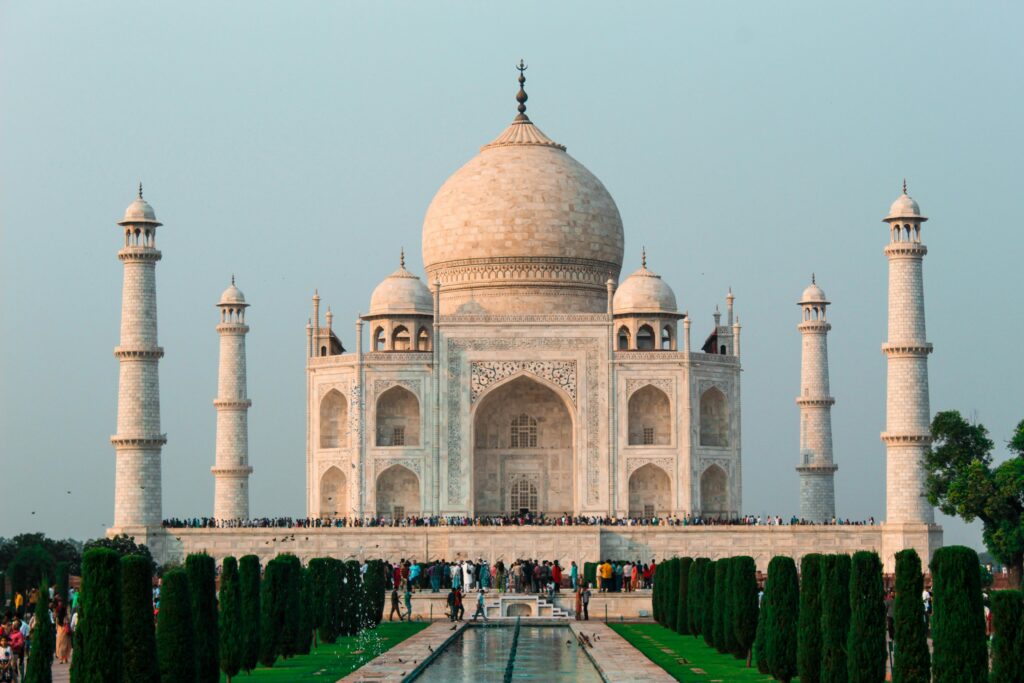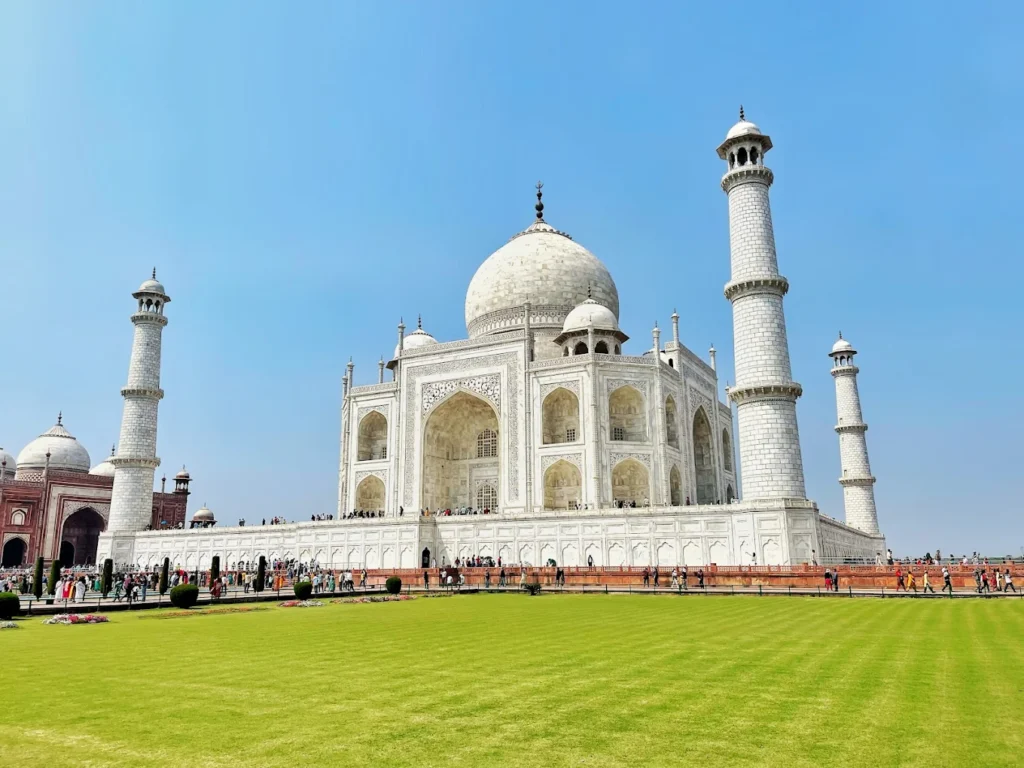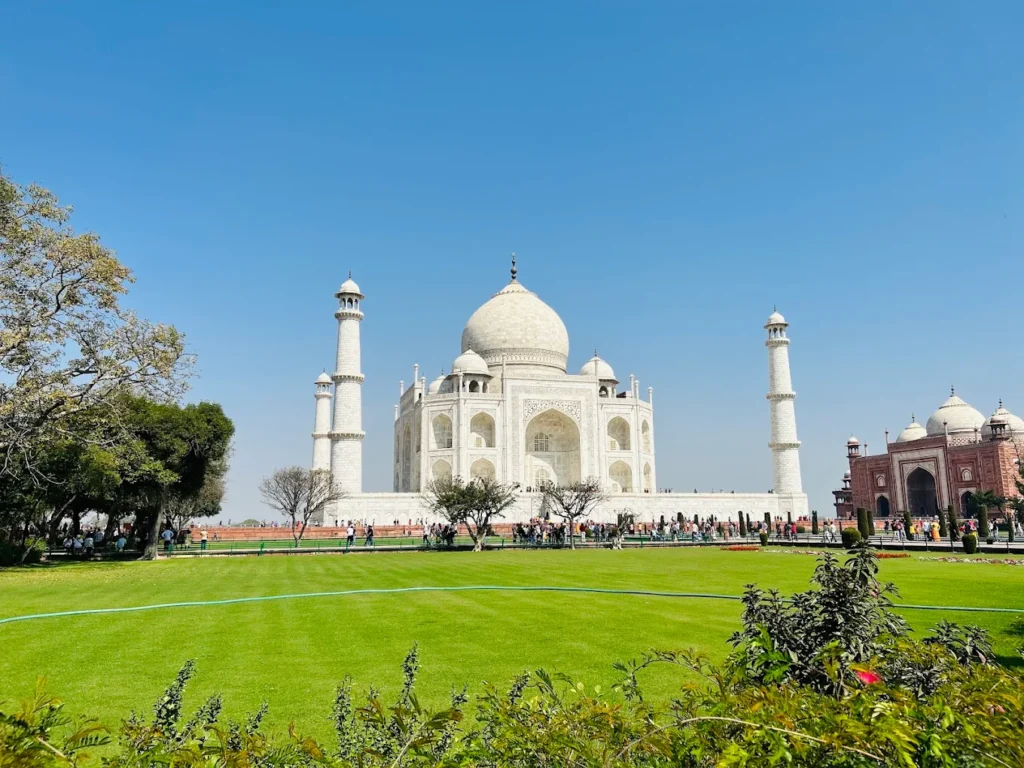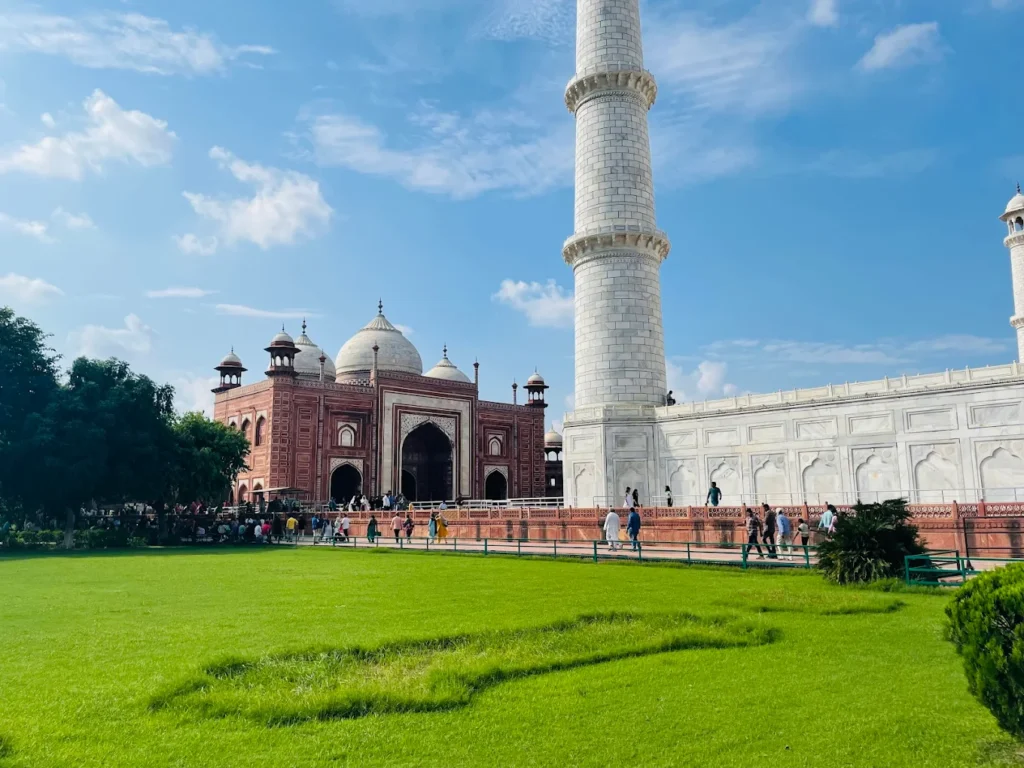Have you ever seen a building that feels more like a poem? A story of love so profound it was literally set in stone? Standing majestically on the banks of the Yamuna River in Agra, India, the Taj Mahal isn’t just another tourist destination on your travel bucket list. This UNESCO World Heritage site has captured hearts and imaginations for nearly four centuries, earning its place as one of the most recognizable and beloved monuments in the world.
More than just an architectural marvel, the Taj Mahal represents the pinnacle of Mughal artistry and serves as an eternal symbol of undying love. It’s a place where history comes alive, where every marble surface tells a story, and where millions of visitors each year find themselves moved to tears by its breathtaking beauty. For travelers from around the globe, the first glimpse of this ivory-white masterpiece emerging through the morning mist is a moment that stays with them forever.
In this comprehensive guide, we’ll journey through the complete story of the Taj Mahal. We’ll explore its heartbreaking history, marvel at its architectural genius, and give you practical tips for your own visit, all based on thoroughly researched information from authoritative sources. Whether you’re planning your first trip to India or you’re simply curious about world heritage sites, this article will serve as your ultimate resource.
So, let’s uncover the answer to the big question: What is the Taj Mahal famous for? Prepare to discover why this 17th-century monument continues to be celebrated as one of humanity’s greatest achievements.

A Love Story for the Ages: The Real Story of the Taj Mahal
Behind every great monument lies a great story, but few tales are as captivating as the one that gave birth to the Taj Mahal. This isn’t just architectural history – it’s a love story that has moved hearts for over 350 years.
Our story begins in the opulent courts of the Mughal Empire with Emperor Shah Jahan, the fifth Mughal ruler, and his beloved wife, Arjumand Banu Begum, better known by her title Mumtaz Mahal, meaning “Chosen One of the Palace.” Theirs wasn’t an arranged marriage born of political necessity, but a genuine love match that blossomed into one of history’s most celebrated partnerships.
Shah Jahan and Mumtaz Mahal were inseparable. She was his trusted confidante, accompanying him on military campaigns and serving as his closest advisor. Contemporary accounts describe their relationship as extraordinarily close, with the emperor seeking her counsel on matters of state and showering her with affection that was unusual for royal marriages of that era. Together, they had 14 children, though sadly, only seven survived to adulthood.
The fairy tale took a tragic turn in 1631 when Mumtaz Mahal died during childbirth while giving birth to their daughter Gauharara Begum. The emperor was devastated beyond measure. Historical records describe Shah Jahan as being so grief-stricken that his hair turned white almost overnight, and he went into mourning for two years, during which he avoided public appearances and banned music and festivities from his court.
But from this profound grief came an extraordinary promise. On her deathbed, Mumtaz Mahal is said to have asked her husband to build her a tomb that would be unlike anything the world had ever seen – a monument that would serve as an eternal symbol of their love. Shah Jahan vowed to create a paradise on Earth in her memory, and thus began one of history’s most ambitious architectural projects.
The construction of the Taj Mahal began around 1632 and would consume 22 years of Shah Jahan’s life and an estimated 32 million rupees – an astronomical sum that would be worth billions in today’s currency. Imagine 20,000 artisans, sculptors, calligraphers, and craftsmen working tirelessly under the guidance of master architect Ustad Ahmad Lahori. The scale was breathtaking: precious materials were transported from across Asia by a fleet of over 1,000 elephants, including white marble from Makrana in Rajasthan, jasper from Punjab, jade and crystal from China, turquoise from Tibet, lapis lazuli from Afghanistan, sapphire from Sri Lanka, and carnelian from Arabia.
The emperor spared no expense in his quest for perfection. He summoned the finest craftsmen from across his empire and beyond – Persian calligraphers, Florentine specialists in pietra dura (stone inlay work), and French and Italian experts in decorative arts. Each element was planned with meticulous attention to detail, from the perfectly proportioned dome to the intricate floral patterns that would adorn every surface.
But the story doesn’t end with the completion of the mausoleum. Legend has it that Shah Jahan planned to build an identical black marble tomb for himself on the opposite side of the Yamuna River, connected to Mumtaz’s tomb by a bridge. However, fate intervened when his son Aurangzeb imprisoned him in 1658, ending these grandiose plans. Shah Jahan spent his final years under house arrest in Agra Fort, where he could gaze upon his beloved’s tomb through a window. When he died in 1666, he was buried beside Mumtaz Mahal in a simple ceremony, their love story finally complete.
This profound narrative of love, loss, and remembrance is why the Taj Mahal resonates so deeply with visitors today. It’s not just a building – it’s the physical manifestation of one of history’s greatest love stories, a testament to the lengths one will go to honor the memory of a beloved partner.
More Than a Building: Decoding the Genius of the Taj Mahal’s Architecture
While the love story captures our hearts, it’s the architectural brilliance of the Taj Mahal that truly explains why this monument has captivated the world for centuries. Every element of its design represents a perfect fusion of Persian, Islamic, and Indian architectural traditions, creating something entirely unique and breathtakingly beautiful.
The most striking feature is undoubtedly the building’s material: translucent Makrana marble. This isn’t just any stone – it’s famous for the way it seems to absorb and reflect light, making the Taj Mahal appear to change color throughout the day. At sunrise, it glows with a soft pink hue, transforms to a pearly white during midday, takes on a golden tint at sunset, and appears almost ethereal and blue under moonlight. This optical illusion was intentional, designed to represent the changing moods of the grief-stricken emperor and the varying emotions of love itself.
The genius of the Taj Mahal lies in its perfect symmetry and mathematical precision. The entire complex is designed as a perfect mirror image, creating a sense of harmony and balance that is incredibly pleasing to the eye. The main mausoleum sits on a square platform measuring 186 feet on each side, topped by a massive central dome that rises 240 feet from the ground. This main dome, known as an onion dome due to its shape, is perhaps the most photographed architectural element in the world.
Flanking the main dome are four smaller domed chambers, called chhatris, each positioned at the corners of the main structure. But perhaps the most ingenious architectural feature is the four minarets that frame the main building. Standing 130 feet tall, these towers aren’t perfectly vertical – they lean slightly outward at an angle of 1.5 degrees. This wasn’t a construction error but a brilliant design choice: in the unlikely event of an earthquake, the minarets would fall away from the main tomb rather than onto it, protecting the precious structure within.
The attention to detail becomes even more apparent when you examine the decorative elements. The Taj Mahal is renowned for its intricate pietra dura inlay work, where semi-precious stones are cut into thin slices and fitted together to create elaborate floral patterns. These aren’t painted designs – they’re three-dimensional art created with materials like jasper, jade, crystal, turquoise, amethyst, and carnelian. The patterns include stylized flowers, vines, and geometric designs that follow Islamic artistic traditions while incorporating Mughal innovations.
The calligraphy adorning the Taj Mahal is equally impressive. Verses from the Quran flow across the structure in beautiful Arabic script, created using black marble inlay. The master calligrapher, Amanat Khan, employed a clever optical illusion technique called “proportional spacing” – the letters become progressively larger as they ascend the building, ensuring they appear uniform in size when viewed from ground level.
The broader complex demonstrates the same attention to symmetrical perfection. The main gateway, or darwaza, serves as both an entrance and a frame for the monument beyond. The charbagh (four-part garden) stretches between the gateway and the mausoleum, divided by water channels that create perfect reflections. The long reflecting pool, known as al Hawd al-Kawthar (Tank of Abundance), serves both aesthetic and symbolic purposes, representing the river of paradise described in Islamic texts.
On either side of the main mausoleum stand two identical red sandstone buildings: a mosque to the west (facing Mecca) and a guest house (or jawab, meaning “answer”) to the east. These structures serve both functional and aesthetic purposes, providing perfect symmetry while the mosque serves as a place of worship.
The acoustic properties of the main chamber represent another architectural marvel. The dome creates a reverberation effect where a single whisper can be heard clearly across the chamber, and any sound made in the center of the dome resonates for nearly 30 seconds. This wasn’t accidental – it was designed to amplify the prayers and Quranic recitations that would echo through the mausoleum.
These architectural innovations and the seamless blend of different cultural traditions explain why the Taj Mahal is so famous among architects, artists, and admirers of beautiful design worldwide. It represents the pinnacle of Mughal architecture and remains an inspiration for architects and artists even today.



What’s Really Inside the Taj Mahal? A Virtual Tour
While the exterior of the Taj Mahal captivates with its grandeur, stepping inside reveals an entirely different kind of beauty – one that’s more intimate, more spiritual, and equally breathtaking. The interior experience is designed to evoke a sense of paradise, with every element carefully planned to create an atmosphere of serene beauty and eternal peace.
As you pass through the main entrance, you’re immediately struck by the contrast between the bright exterior and the softly lit interior. The main chamber, called the tomb chamber, houses the cenotaphs (decorative tombs) of both Mumtaz Mahal and Shah Jahan. However, what many visitors don’t realize is that these beautifully decorated markers are symbolic – the real graves lie in a quiet, simpler crypt directly below, hidden from public view and accessible only to caretakers and special visitors.
The cenotaphs themselves are masterpieces of craftsmanship. Mumtaz Mahal’s cenotaph, positioned at the exact center of the chamber, features delicate floral inlays and Quranic inscriptions praising her virtues and calling upon God’s mercy. Shah Jahan’s cenotaph, added later and slightly larger, sits beside hers – the only element in the entire Taj Mahal complex that breaks the perfect symmetry, as it was never part of the original plan.
Surrounding these memorial markers is an octagonal marble lattice screen called a jali, which is one of the most exquisite examples of marble carving in the world. This screen, with its intricate geometric patterns and delicate floral motifs, serves both practical and aesthetic purposes. It protects the cenotaphs from the touch of countless visitors while creating beautiful patterns of light and shadow as sunlight filters through the perforations. The play of light through these marble screens changes throughout the day, creating an almost mystical atmosphere that adds to the spiritual experience.
The walls of the main chamber are adorned with precious stone inlay work depicting flowers in naturalistic detail – roses, daffodils, and tulips rendered with such precision that they seem almost alive. These aren’t merely decorative elements but carry deep symbolic meaning in Islamic art, representing the gardens of paradise and the eternal spring that awaits the faithful in the afterlife.
The acoustic properties of the interior space are remarkable. The dome above creates a natural amplification system where even the slightest whisper can be heard clearly across the chamber. This acoustic phenomenon transforms the space into a resonating chamber where prayers and recitations can be heard with crystal clarity. The effect is so pronounced that guides often demonstrate it by having visitors stand at specific points and speaking in normal tones, their voices carrying clearly to every corner of the chamber.
Perhaps the most moving aspect of the interior is the quality of light that fills the space. The translucent marble walls glow softly, creating an ethereal atmosphere that changes subtly throughout the day. During sunrise and sunset, the interior takes on warm, golden tones, while during midday, it radiates with a cool, peaceful light. This ever-changing illumination was intentionally designed to represent the passage of time and the eternal nature of love and memory.
The smaller chambers surrounding the main tomb chamber each serve specific purposes and contain their own artistic treasures. These spaces feature similar inlay work and calligraphy, but on a more intimate scale, allowing visitors to appreciate the incredible detail and craftsmanship up close.
For many visitors, the experience of being inside the Taj Mahal is profoundly moving. There’s something about the combination of the soft light, the delicate beauty of the decorations, the acoustics, and the knowledge of the love story behind it all that creates an emotional response. It’s not uncommon to see visitors moved to tears by the beauty and poignancy of the space – a testament to the power of great architecture to touch the human heart.
Why the Taj Mahal is a True Wonder of the World
The Taj Mahal’s fame extends far beyond its romantic origins and architectural beauty – it has earned recognition as one of humanity’s greatest achievements, officially designated as both a UNESCO World Heritage Site and one of the New Seven Wonders of the World. These aren’t honorary titles but recognition of its extraordinary universal value and its importance to all of humanity.
In 1983, UNESCO designated the Taj Mahal as a World Heritage Site, acknowledging it as “the jewel of Muslim art in India and one of the universally admired masterpieces of the world’s heritage.” The UNESCO citation specifically recognizes its outstanding universal value, noting that it represents “the finest architectural and artistic achievement through perfect harmony and excellent craftsmanship in a style of exceptional purity.”
The designation as one of the New Seven Wonders of the World came through a global voting campaign in 2007, where more than 100 million people worldwide cast their votes. The Taj Mahal emerged as one of the seven winners, joining the ranks of other iconic monuments like the Great Wall of China, Machu Picchu, and the Colosseum in Rome. This recognition reflects its status as a symbol not just of India, but of human achievement and artistic excellence.
For many people around the world, the Taj Mahal is India. It’s the image that comes to mind when they think of the country – more recognizable than any other Indian landmark. This iconic status has made it one of the most photographed buildings in the world and a must-visit destination for travelers from every continent. The monument receives between 7-8 million visitors annually, making it one of the most visited tourist attractions globally.
The Taj Mahal’s influence extends beyond tourism into popular culture, art, and literature. It has inspired countless artists, poets, writers, and filmmakers. Nobel laureate Rabindranath Tagore famously called it “a teardrop on the cheek of time,” while British poet Sir Edwin Arnold described it as “not a piece of architecture, as other buildings are, but the proud passions of an emperor’s love wrought in living stones.”
The monument’s cultural significance also lies in its representation of India’s rich multicultural heritage. Built during the Mughal period, it represents the synthesis of Islamic, Persian, Turkish, and Indian architectural traditions. This fusion makes it a symbol of cultural harmony and artistic collaboration – values that resonate strongly in our increasingly connected world.
From a technical standpoint, the Taj Mahal continues to amaze engineers and architects with its advanced construction techniques. The foundation system, designed to withstand earthquakes and the soft riverbank soil, remains stable after nearly 400 years. The precision of its proportions, the innovative use of materials, and the ingenious solutions to architectural challenges continue to influence modern architects and engineers.
The conservation efforts surrounding the Taj Mahal also highlight its global importance. The Indian government, with support from international organizations, invests millions of dollars annually in preservation work. Recent restoration projects have included cleaning the marble surfaces affected by air pollution, reinforcing the foundation, and implementing strict environmental controls to protect the monument for future generations.
This combination of historical significance, architectural brilliance, cultural importance, and global recognition explains why the Taj Mahal stands as a true wonder of the world – not just as a beautiful building, but as a testament to human creativity, love, and the enduring power of great art to move and inspire people across cultures and centuries.
Planning Your Visit? Your Top Questions Answered
Where is the Taj Mahal located? The Taj Mahal is located in Agra, in the northern Indian state of Uttar Pradesh. Agra is approximately 125 miles (200 kilometers) southeast of New Delhi, making it easily accessible for international visitors. The journey from Delhi takes about 3-4 hours by car or train, and there are excellent transportation options including express trains, buses, and organized tour services.
How old is the Taj Mahal? The Taj Mahal was completed around 1653, making it nearly 400 years old. Construction began in 1632 shortly after Mumtaz Mahal’s death in 1631, and the main mausoleum was finished by 1648. The surrounding complex, including the mosque, guest house, and gateway, took an additional five years to complete.
Is the Taj Mahal really a wonder of the world? Yes! The Taj Mahal holds the prestigious designation as one of the New Seven Wonders of the World, chosen by more than 100 million votes worldwide in 2007. It’s also a UNESCO World Heritage Site, recognized for its outstanding universal value to humanity. These aren’t just honorary titles but acknowledgment of its extraordinary architectural, historical, and cultural significance.
Who built the Taj Mahal and why? Mughal Emperor Shah Jahan commissioned the Taj Mahal as a mausoleum for his beloved wife, Mumtaz Mahal, who died during childbirth in 1631. The monument was built as an eternal symbol of their love and serves as her final resting place. Shah Jahan himself was later buried beside her when he died in 1666.
What’s the best time to visit? For the most magical experience, plan your visit for sunrise when the monument glows with soft pink and golden hues, and crowds are at their smallest. The best months to visit are October through March when the weather is cooler and more comfortable. Avoid visiting on Fridays when the mosque is closed for prayers, and remember that the Taj Mahal is closed on Mondays except during the peak tourist season.
How much time should I plan for my visit? Most visitors spend 2-3 hours exploring the complete complex, including the main mausoleum, mosque, guest house, and gardens. If you’re particularly interested in photography or architecture, you might want to allocate 4-5 hours. Consider that entry procedures can take time, especially during peak tourist seasons.
What should I know before visiting? Photography of the interior tomb chamber requires a special ticket, and tripods aren’t allowed inside the main mausoleum. Visitors must remove their shoes or wear shoe covers before entering the main building. Security is tight, so avoid bringing large bags, food, or unnecessary electronics. The closest you can get by car is the parking area; from there, you’ll need to take an electric bus or walk to the main entrance.
Conclusion
The Taj Mahal’s fame rests on three pillars that have made it one of the most beloved monuments in human history: its extraordinary origin story as the ultimate expression of eternal love, its breathtaking architectural perfection that represents the pinnacle of Mughal artistry, and its recognition as a global icon that transcends cultural boundaries to speak to the universal human experience.
From Shah Jahan’s grief-stricken promise to his dying wife to the 22-year labor of love that followed, from the mathematical precision of its symmetrical design to the way its marble surfaces seem to capture and reflect the very essence of light and time, the Taj Mahal stands as proof that the greatest achievements in human history are born from the deepest emotions of the human heart.
The Taj Mahal is more than just a place to visit; it’s a testament to the enduring power of human emotion and creativity. It’s a story waiting to be experienced, reminding us that the greatest things in life are truly built from the heart. Whether you visit at sunrise when it glows like a pearl against the morning sky, or you simply admire it through photographs and stories, the Taj Mahal continues to inspire and move people nearly four centuries after its completion – and that, perhaps, is the most beautiful testament to its eternal fame.
About the Author: As the founder of XploreHeaven and a passionate travel expert, I believe in sharing the world’s most beautiful stories through comprehensive guides that inspire and inform. With extensive research into history, culture, and architecture, my goal is to create resources that help travelers connect deeply with the destinations they visit, transforming trips into meaningful experiences that last a lifetime.
For Further Reading & Fact-Checking
We believe in providing trustworthy and accurate information. The historical and architectural details in this article were cross-referenced with the following authoritative sources:
- The official UNESCO World Heritage Centre page for the Taj Mahal
- Archaeological Survey of India official documentation
- Articles from National Geographic on Mughal architecture and history
- Smithsonian Institution resources on Indo-Islamic art
- Academic publications on 17th-century Mughal construction techniques
- Koundinya Wildlife Sanctuary Travel Guide 2026: Timings, Safari, Map, Reviews & Wildlife Highlights
- Kaas Plateau Travel Guide 2026: Best Time to Visit, Bloom Season, How to Reach & FAQs
- What Is the Quirimbas Archipelago Mozambique Known For? Complete Travel & Nature Guide
- Is Angola Safe to Travel in 2025? Your Essential Guide to Health, Crime, and Landmine Safety
- What Animals Live in Bale Mountains Ethiopia? Complete Wildlife Guide
